TS 42.043
SoLSA –
Support of Localised Service Area
Service Description – Stage 1
V18.0.0 (PDF)
2024/03 14 p.
V17.0.0
2022/03 14 p.
V16.0.0
2020/06 14 p.
V15.0.0
2018/06 14 p.
V14.0.0
2017/03 14 p.
V13.0.0
2016/01 14 p.
V12.0.0
2014/10 14 p.
V11.0.0
2012/09 14 p.
V10.0.0
2011/04 14 p.
V9.0.0
2009/12 14 p.
V8.0.0
2009/01 14 p.
V7.0.0
2007/06 14 p.
V6.0.0
2004/12 14 p.
V5.0.0
2002/07 14 p.
V4.0.0
2001/04 14 p.
GSM Rel-99 v8.0.0
2001/05 14 p.
GSM Rel-98 v7.3.0
2000/09 13 p.
- Rapporteur:
- Miss Miettinen, Natalia
NOKIA UK R&D Ltd
Content for TS 42.043 Word version: 18.0.0
1 Scope
2 References
3 Definitions and abbreviations
4 Description
4.1 Defining subscriber information for localised service area
4.2 Service Features
4.2.1 Localised service area indication
4.2.2 Localised service area support in idle mode (camping)
4.2.3 Localised service area support in active mode (handover)
4.2.4 Exclusive access
4.2.5 LSA only access
4.2.6 Preferential access
5 Impact on other services
5.1 General
5.3 GPRS
5.4 Call Forwarding
5.5 Completion of Calls to Busy Subscriber (CCBS)
5a Exceptional procedures
6 Charging aspects
7 Commercial Role Model for SoLSA
$ Change History
1 Scope p. 5
This technical specification, specifies a mechanism, which can be used as a platform for providing special tariffs and/or special set of service features for certain subscribers within a regionally restricted area or areas.
The motivation for this concept is to create means for network operators to build new service and tariff packages, which take into account subscriber groups and their needs.
The localised service area is both an optional network feature and an optional UE feature. Usage and implementation of the different SoLSA service features may vary according to operator's service packages.
This feature is not intended to replace the existing method of cell selection, cell indication and handover.
"Support of Localised service area (SoLSA)" is renamed Phase 2+ item "Support of Home Area Priority"
2 References p. 5
The following documents contain provisions which, through reference in this text, constitute provisions of the present document.
- References are either specific (identified by date of publication, edition number, version number, etc.) or non specific.
- For a specific reference, subsequent revisions do not apply.
- For a non-specific reference, the latest version applies. In the case of a reference to a 3GPP document (including a GSM document), a non-specific reference implicitly refers to the latest version of that document in the same Release as the present document.
3 Definitions and abbreviations p. 6
3.1 Definitions p. 6
Localised Service Area (LSA):
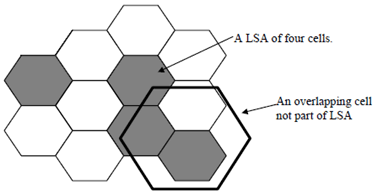 Subscribed to LSA:
Subscribed to LSA:
A localised service area consists of a cell or a number of cells within a PLMN.
Cells being part of different localised service areas may have overlapping coverage areas. The cells constituting a localised service area may not necessarily provide continuous coverage.

Set of LSAs, which the user has subscribed to.
Valid LSA:
A LSA ,whichthe user has subscribed to and his UE can receive service.
Current LSA: The LSA where a UE is receiving service.
LSA Priority:
Priority of subscriber's LSAs. When the user has several valid LSAs, the current LSA shall be selected by prioritising LSAs in case of overlapping LSAs.
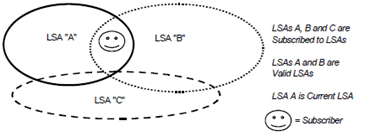
LSA only access:
LSA user is allowed to access PLMN within his allowed LSAs. LSA user is not allowed to receive and/or originate a call outside LSA area.
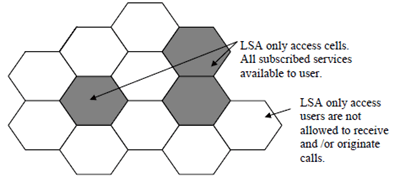
Exclusive Access:
Access to exclusive access cells is restricted to defined LSA subscribers.
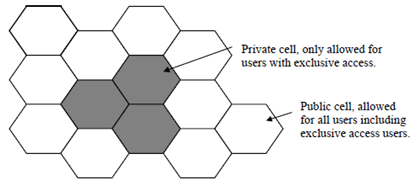
Preferential Access:
LSA user shall have preferential access to resources of LSA cells, compared to non-LSA users.
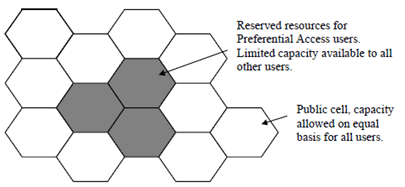
3.3 Abbreviations p. 7
For the purposes of the present document, the following abbreviations apply:
LSA
Localised Service Area
Further abbreviations may be found in TR 21.905.
4 Description p. 8
The localised service area concept shall give the operator the basis to offer subscribers different services (e.g. tariffs or access rights) depending on the location of the subscriber.
4.1 Defining subscriber information for localised service area p. 8
A subscriber can have up to 20 LSAs per PLMN.
It shall be possible to assign localised service areas to subscribers. Subscriber may have service, which contains several LSAs potentially belonging to different PLMNs. There shall be means to allocate LSA priority to each subscriber independently by operator.
Localised service areas for subscriber(s) may overlap, i.e. one cell may be part of several LSAs belonging to that subscriber.
As an example, within a hierarchical cell structure, cells in different layers can constitute different localised service areas. A localised service area could be defined so that it is possible to establish flexible sized areas, which are applicable to
- a very small localised service area ("home area" covering one or several cells dedicated e.g. to a residential subscriber or a company); or
- a large area covering a part of the city (one or several location areas); or
- a combination of these.
4.2 Service Features p. 8
Following service features are building blocks for SoLSA based services. It is up to the operator to decide which service features are required for a specific service.
- Localised service area indication.
- Localised service area support in idle mode (camping).
- Localised service area support in active mode (handover).
- LSA only access.
- Exclusive access.
- Preferential access.
4.2.1 Localised service area indication p. 8
It shall be possible to assign a subscriber defined identifier by the operator to each LSA (alphanumeric text up to 10 characters), which can be provided to the user in idle and active mode. As a UE manufacturer option the user may assign an icon or another form of indication to each LSA.
It shall be possible to indicate a change of localised service area during idle and active mode.
The indication is a network option (activated/deactivated by the network).
4.2.2 Localised service area support in idle mode (camping) p. 9
The PLMN shall determine, which cells, belonging to the LSA, are to be favoured by the UE when camping.
When camping on a cell in idle mode, the subscriber's mobile station shall use the information provided by the PLMN in selecting cells belonging to his localised service area. The mobile station shall have the ability to reselect a cell in a different LSA with higher priority. This favouring shall not degrade the overall service quality.
There should be no extra delay in cell selection procedure.
4.2.3 Localised service area support in active mode (handover) p. 9
The PLMN shall determine, which cells, belonging to the LSA, are to be favoured during active mode.
The cells belonging to users LSAs shall be favoured at call setup and when handovers are carried out. This favouring shall not degrade the overall service quality.
4.2.4 Exclusive access p. 9
For a cell belonging to one or more service areas and where only one or more specific subscribers shall have allowed access, other subscriber's mobile stations shall be prevented from using the cell to obtain any service, other than TS12 (Emergency Calls).
Handovers into cells belonging to localised service areas where only specific subscribers shall have allowed access, shall be possible to be prevented for other subscribers, if required by a SoLSA application.
4.2.5 LSA only access p. 9
With access allowed only within one or more localised service areas, it shall be possible to prevent receiving and/or originating basic services from non-LSA cells. SMS and Supplementary service operations are allowed in all areas.
It shall be possible to prevent handovers to cells not belonging to allowed localised service areas, if required by a SoLSA application.
4.2.6 Preferential access p. 9
It shall be possible to allocate resources at call setup and during the active mode to LSA users, if required by a SoLSA application.
5 Impact on other services p. 9
5.1 General p. 9
SoLSA is not limited to specific services and there are no modifications necessary for existing services. In particular there shall be no impact to Emergency Call (TS12).
LSA should be able to support all tele, bearer and supplementary services .There is no interaction to supplementary services except those specified below.
5.2 Void
5.3 GPRS p. 10
It shall be possible to apply SoLSA services independently to circuit switched services and to GPRS. LSA support in idle mode shall be specified for GPRS.
The definition of routing areas and the definition of localised service areas shall be independent of each other.
5.4 Call Forwarding p. 10
No interaction.
5.5 Completion of Calls to Busy Subscriber (CCBS) p. 10
LSA only access restrictions shall apply to CCBS recall.
5a Exceptional procedures p. 10
None identified.
6 Charging aspects p. 10
Based on the use of the feature "Support of Localised Service Area" it is possible to establish local tariff applications ("home zone applications").
7 Commercial Role Model for SoLSA p. 11
SoLSA shall support LSAs which, do not belong to the HPLMN. To enable this the following commercial role model shall be used:
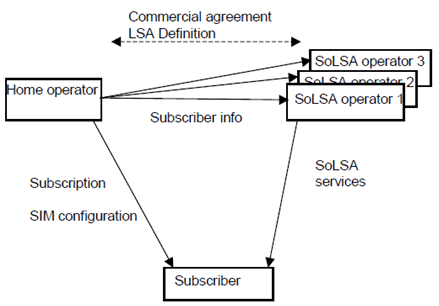
The actors of the SoLSA role model are defined below:
- Home operator: The Home operator of a SoLSA subscriber is the owner of the SIM for this subscriber. As such, he is responsible for transferring the necessary SoLSA information to the subscriber SIM. He also holds the SoLSA subscriber information (e.g. in the HLR, CAMEL server, private network node). The Home operator has a commercial agreement with one or several SoLSA operators. A Home operator can be commercially the same entity as a SoLSA operator.
- SoLSA operator: An operator is acting as a SoLSA operator for one SoLSA subscriber if he owns at least one Localised Service Area (LSA) for that subscriber. As such, when the user is attached to the SoLSA operator the SoLSA operator will provide the service for the SoLSA. One SoLSA operator can own a multiplicity of LSAs for a given SoLSA subscriber. A SoLSA operator has a commercial agreement with one or a multiplicity of Home operators (but maximum one per subscriber). A SoLSA operator can be commercially the same entity as the Home operator.
- SoLSA subscriber: A SoLSA subscriber is a subscriber who has subscribed to one Home operator and at least one SoLSA operator (or said differently, who has an authorisation to receive services from at least one LSA). A SoLSA subscriber can have a subscription with a multiplicity of SoLSA operators. A subscriber has always a Home operator, but for example if he is allowed to have services only in LSAs, his Home operator and his SoLSA operator can be commercially the same entity.